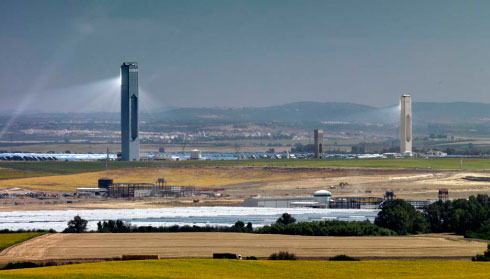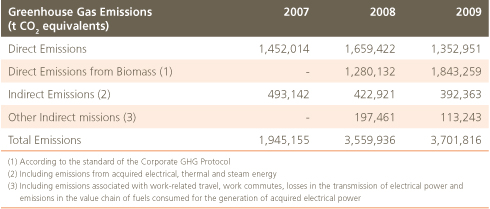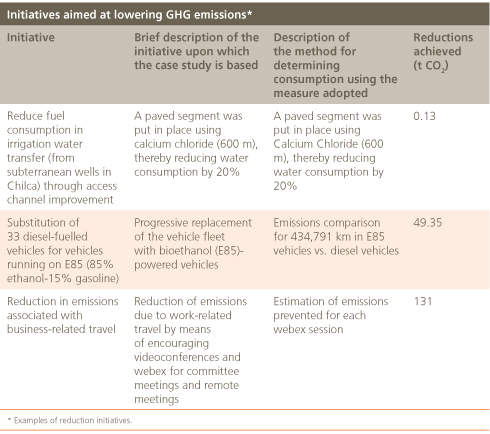 Abengoa
Abengoa
Annual Report 2009
- Corporate Social Responsibility Report
- The Environment and Climate Change
- Climate Change and Other Emissions into the Atmosphere
Climate change is undoubtedly the greatest challenge facing humanity for the coming years. It is already causing physical changes and the consequences are affecting productive systems, resource availability and the social balance of the planet. Climate change therefore affects the security and viability of human society.
There is therefore a clear need to take steps to reduce GHG emissions, with a view to maintaining GHG atmospheric concentration at levels which, while still producing inevitable climate changes on Earth, keep these changes at levels that are compatible with today’s living conditions.
Thus, one of the conclusions of the UN Climate Change Conference held in Copenhagen last December is the need to maintain the Earth’s rise in temperature at below 2ºC.

Photo taken by Manuel Javier Vázquez, from Telvent, to the 1st Edition of the Abengoa Sustainability Photography Contest
The problem affects the entire world and requires global solutions. It is not enough for one country to lower its emissions, but rather all nations worldwide must make a concerted effort to control and reduce their emissions. It is essential that decisions be made at a global level to enable economic development in the coming years in concert with a global reduction in greenhouse gas emissions. In short, the decision-making process must enable sustainable development.
In this area, the role of governments across the world is twofold; on the one hand, it requires them to have the capacity to reach international agreements to enable a GHG emission reduction that is gradual, balanced and fair, given that levels vary significantly from country to country. It is essential that countries with higher standards of living and which therefore generate more emissions be the ones to undertake greater reduction levels. It also demands that those that are furthest behind tread a different path towards development, carefully avoiding the profit and convenience-oriented paths followed in the past.
On the other hand, the world’s governments must promote, each within their own countries, a legal framework leading to the corresponding emissions reduction. This necessitates assessment of the GHG emissions generated by citizens and businesses and internalization of the negative effects of these emissions into the costs of the different products and services. Current systems of emission rights trading are but a fledgling mechanism in this direction, which requires a profound change in order for it to be effective.
Greenhouse gas emissions stem from the use of fossil fuels and no meaningful reduction in GHG emissions will be possible without changing the energy model that gives rise to them. Maintaining the present model, which is based on more than 80% of the energy consumed in the world being of fossil origin, is simply incompatible with halting climate change.
Renewable energies must play a key role in this new model. Solar and wind power and biofuels represent a viable alternative that is already available commercially today. Hydrogen as an energy vector could also play a significant role in the medium term.

Solar radiation cast down onto the Earth is on the order of ten thousand times our current energy consumption. Solar radiation is thus a source that can meet our needs even if we are only able to capture just a minimal proportion. At present, the costs of producing photovoltaic and solar thermal-based electrical power are nearing those of fossil fuel production. Widespread development and deployment of this kind of energy coupled with internalization of emissions costs associated with fossil energies would make it both environmentally and economically profitable almost instantly with respect to fossil fuels. Solar thermal energy also enables thermal storage systems, which make it easier to manage integration into the power grid.
Wind power, in turn, also represents an energy source which in a limited but significant way may contribute to a totally or fundamentally renewable mix.
In the transportation sector, the cause of approximately a quarter of all GHG emissions, energy sources must be transportable. The use of batteries poses significant limitations to autonomy, features and prices. In this field, biofuels are a currently available solution allowing hybrid cars or vehicles with a conventional internal combustion engine to reduce their emissions quite significantly. In the case of automobiles running on E85 (85% bioethanol, 15% gasoline) of average environmental quality, emission reduction would be more substantial than for electric cars with the same power output running on the European electrical mix. The use of biofuels enables us to maintain all of the features of today’s vehicles, while maintaining their autonomy, and they do not require any significant modification to the current supply network or any increase in vehicle cost. Flexi-fuel vehicles that run on biofuel, as well as biofuels that enable a GHG reduction of between 35% and 50%, are commercialized today in different parts of the world. More widespread use of second-generation lignocellulosic biofuels, currently at the demonstration plant stage, will lead to an even greater reduction in the GHG emissions produced by transportation.

The change in the energy model is not only necessary, but represents a tremendous opportunity for taking the leap towards economic development by generating wealth and employment in a way that is environmentally and socially sustainable. This new model will lead not only to development, but to energy independence and security in the Western world.
The GHG emissions inventory conducted in 2009 by all of Abengoa’s companies and Business groups constitutes a complete overview of the company’s activities and commitment to preserving our climate.
Emissions
Calculation of greenhouse gas (GHG) emissions takes into account the direct emissions of all sources that are owned by Abengoa (combustion, process, transportation and fugitive emissions), indirect emissions from acquired electrical power, thermal energy and steam and the indirect emissions resulting from work-related travel, work commutes, losses in the distribution and transmission of electrical power and emissions in the value chain of fuels consumed for generating acquired electrical power. Likewise, the emissions involved in biomass combustion and processing are reported separately.
Emissions were calculated on the basis of the IPCC and GHG Protocol methodologies, using, whenever possible, specific fuel emission factors; in other cases, national GHG inventory values of the countries in which our activities are carried out, and, as a last resort, generic figures published by the IPCC.

The rise in emissions in 2008 can be put down to the increased number of companies included within the scope of consolidation and the implementation of emissions calculation methodologies.
For Abengoa, the greenhouse gas emissions inventory is a complete and mature instrument for ensuring responsibility with respect to climate change.
With respect to other techniques for footprint analysis of local scope, complete accounting of emissions commits all Abengoa companies, in all territories, to integrating the supply value chain into the process of calculating emissions.
Emission measurement through the inventory of Abengoa has comparative advantages over other instruments: it is thorough, both in terms of its scope of consolidation and other scopes; it is verifiable both internally and externally; it constitutes a global model upon which to base reduction targets; and it binds suppliers to climate preservation policies.

There was no record in 2007 and 2008 via the Abengoa information channels of significant emissions of ozone layer-depleting substances deriving from company activity over the last three years.
Emissions recorded in 2009 are listed below.


Greenhouse gas emissions stem from the use of fossil fuels and no meaningful reduction in GHG emissions will be possible without changing the energy model that gives rise to them